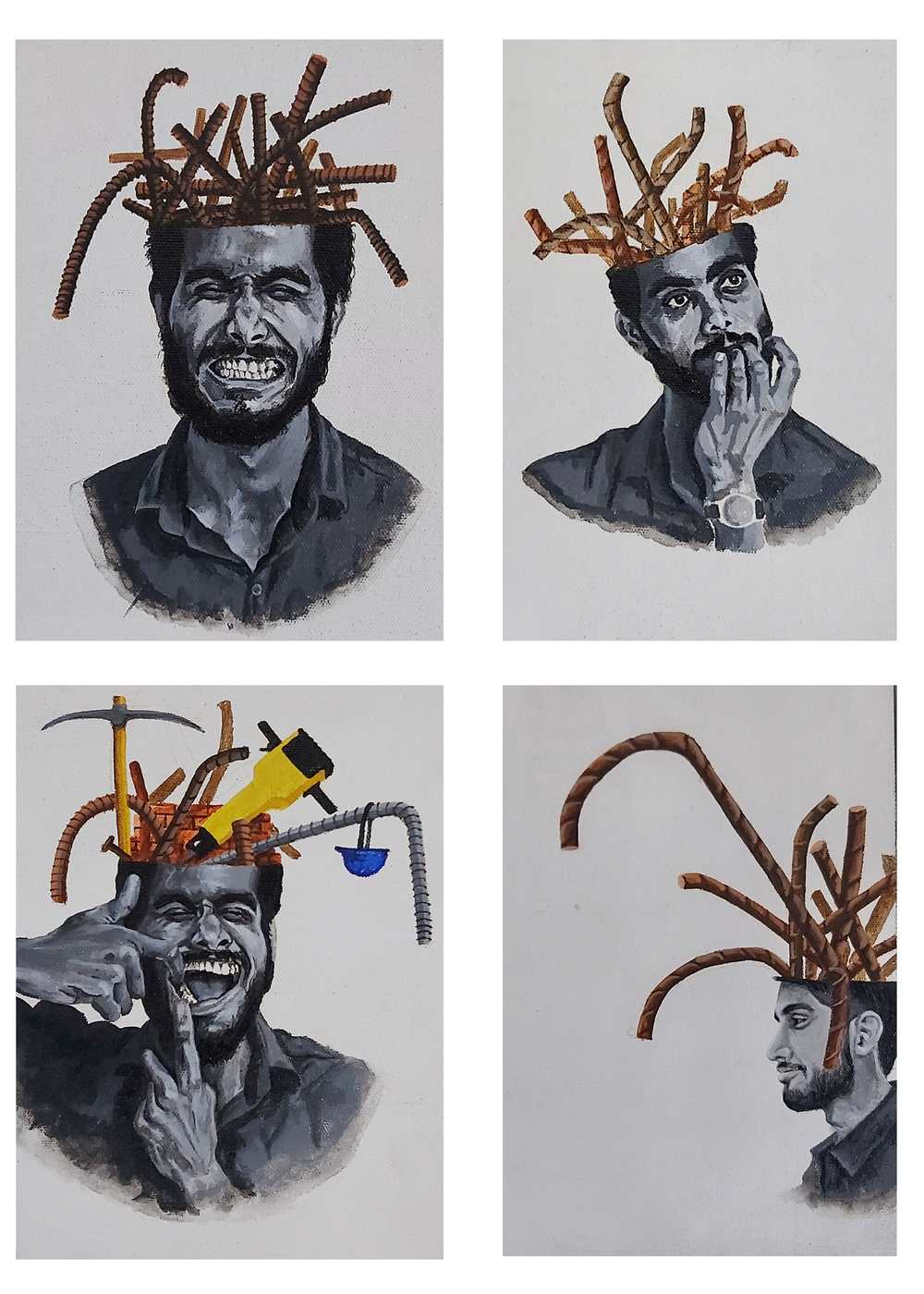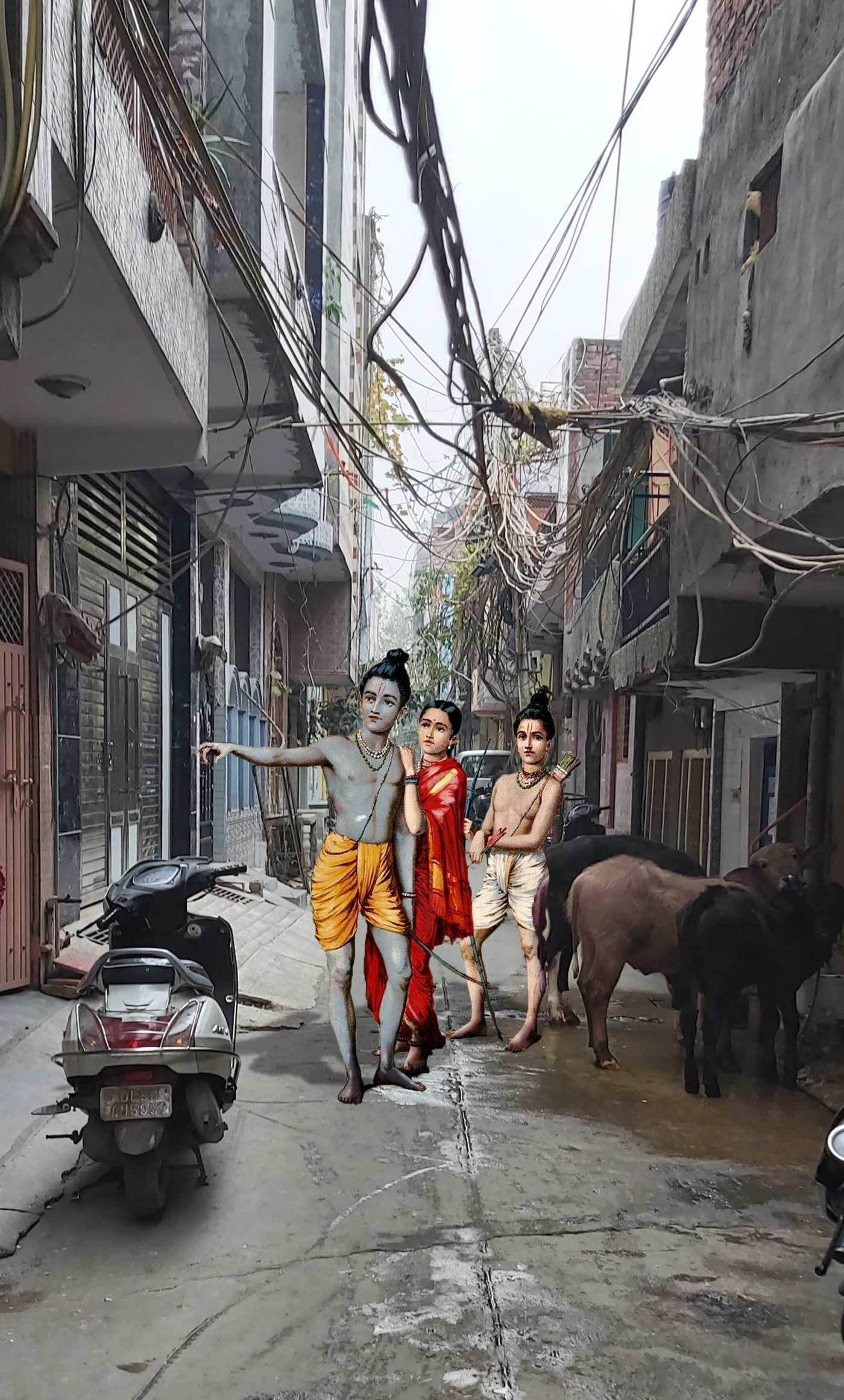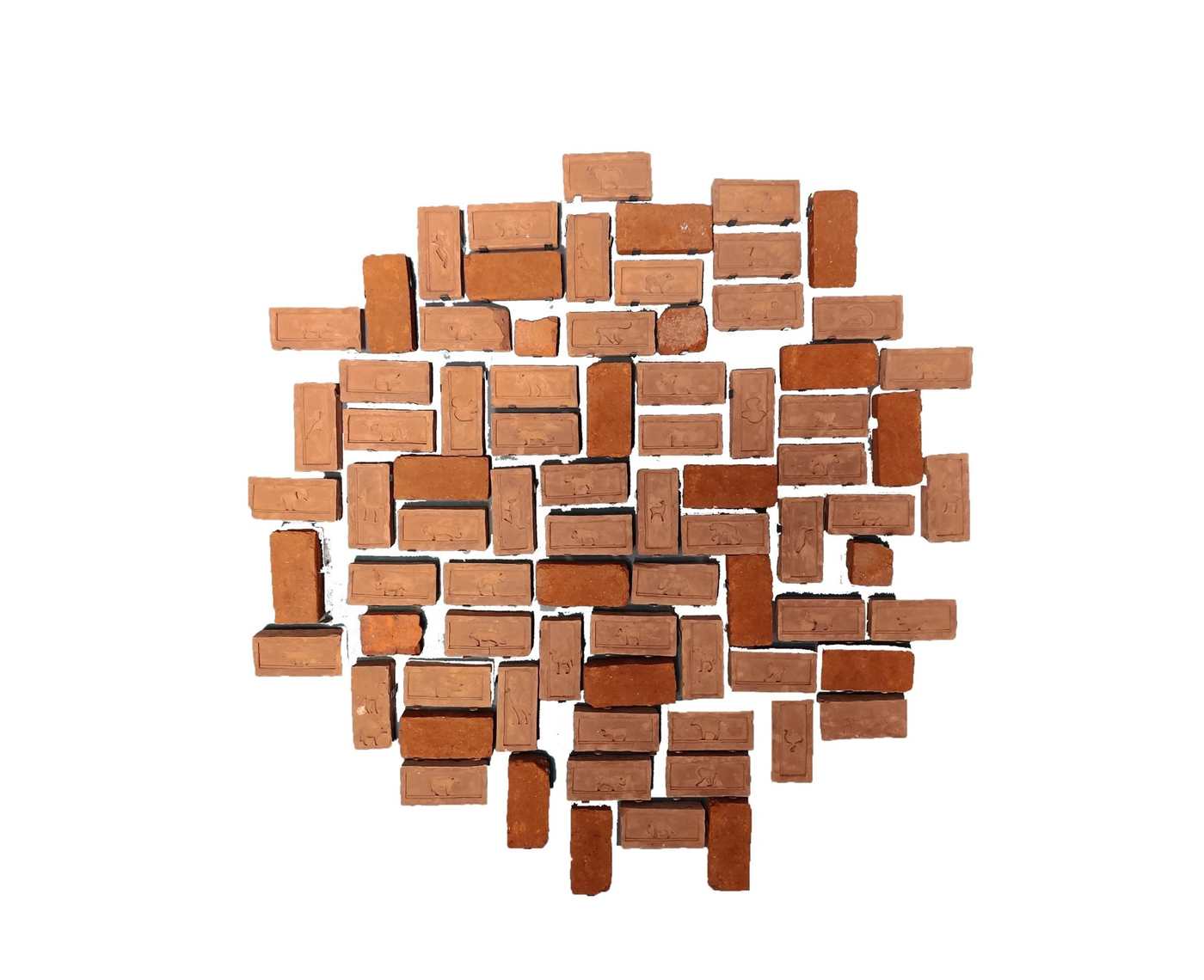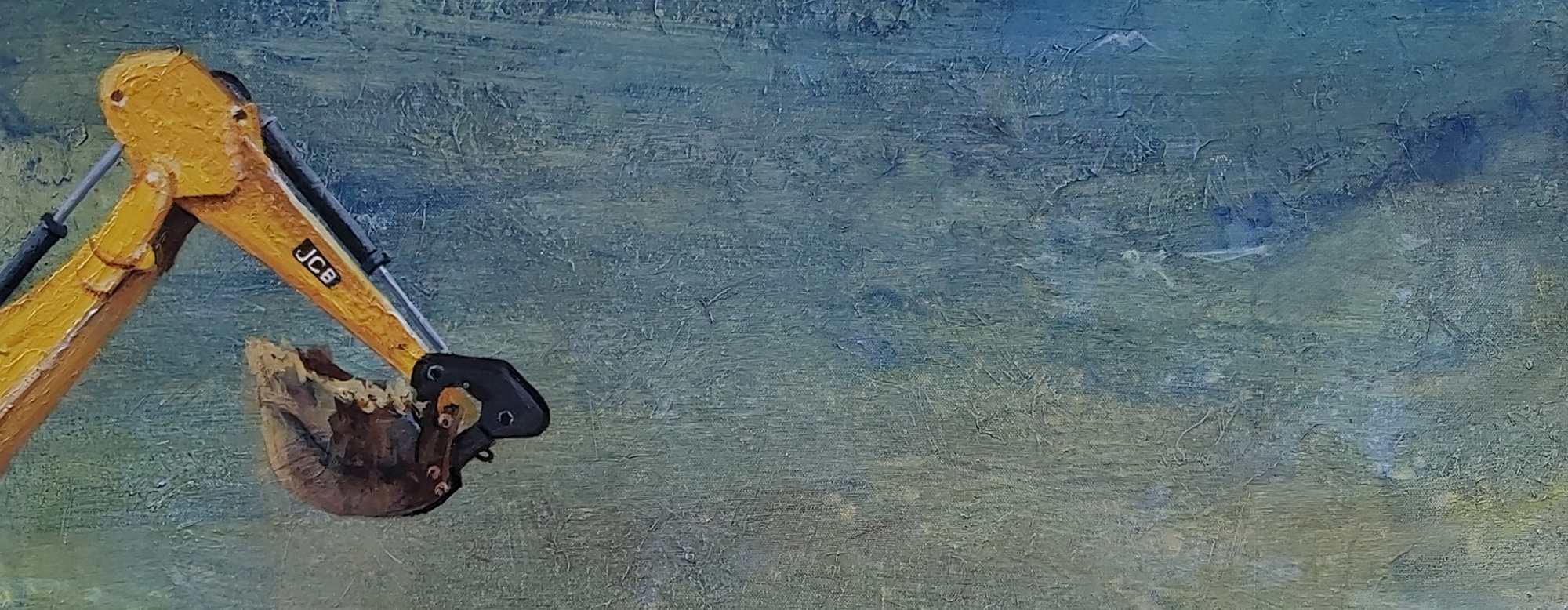#InConversation with Deepak
By Davangi Pathak | Jan 3 2024 · 10 mins
Deepak is a Delhi-based artist, whose practice centers on the ever-changing landscape of the human mind and society. He keenly observes these dynamic changes, seamlessly incorporating their essence into his works. Through this conversation, we aim to understand about Deepak’s praxis and his future goals.


Expression, 2020


The Pillar, 2020
Davangi: In our earlier conversation you mentioned your journey to pursue art was not direct and your initial idea about art was different. Would you like to tell more about it? How did the transformation motivate you further to pursue art?
Deepak: To start with, I would like to express my heartfelt gratitude for providing me and my art the opportunity to share our journey and process on this platform. In my formative years, during school, the subject of drawing was only prevalent until class 7 or 8. Subsequently, as is customary, everyone found themselves contemplating the critical decision of choosing between science, arts, or commerce for their future endeavors. I too found myself entangled in this decision-making process, inadvertently sidelining my passion for art. Upon completing my schooling, I embarked on the path of Chartered Accountancy (CA) CPT during graduation. However, amidst the confusion of those years, my weak foundation in CA led to failure. It was at this juncture that I confided in my elder brother about my prior accomplishment—a portrait painting. In response, he promptly procured the application form for a Bachelor of Fine Arts (BFA) in Painting from Delhi College of Art and submitted it on my behalf.
Entering the college premises on the day of the entrance exam, I was initially confident, assuming that admission into a painting course would be relatively unchallenging due to societal perceptions. To my surprise, 500 to 1,000 students converged for the entrance, and the atmosphere, coupled with the skills displayed by fellow aspirants, left a lasting impression on me. Despite my initial overconfidence, I failed the entrance exam three times. Undeterred, I enrolled in a private institute (Technia Institute of Art and Design affiliated with IKSV Khairagarh). Here, I delved into the fundamentals of art—exploring various types of pencils, understanding the nuances from 2B to 6B, and honing my skills in drawing. I realized that art extended beyond portraiture; it encompassed a diverse range of forms and expressions. Consequently, my perspective on art began to evolve, and I started diverging from societal norms. In my third year of college, I got into conceptual art, studying renowned artists, attending gallery exhibitions, and drawing inspiration from the distinctive style of Manjunath Kamath sir. This marked a transformative period, as I gradually transitioned from emulation to developing my unique artistic concepts. Art became a grounding force, connecting me to reality and prompting a shift in my mindset—a newfound ability to perceive situations from a different perspective.


Construction Site I, 2020


Construction site II, 2020
Davangi: In your body of works like ConstructionSite I & II, you had mentioned that as a concept, the idea came in your mind during your 4th year in college. When you started observing your surroundings. The very first thing you observed nearby your home is the reconstruction of homes from old to modern forms. Would you like to tell us more about it? Please give us more insight about the conceptualisation and the process through which you incorporated those elements in your work.
Deepak: Before the onset of the Covid pandemic, the ongoing construction activities in my surroundings used to elicit a sense of irritation within me. I channeled these emotions into my artistic expression, specifically in the form of 'face expression,' and subsequently created an installation centered around this theme. My approach involved incorporating the diverse array of thoughts constantly traversing my mind into my artworks. Given the ever-shifting landscape of human cognition, I explored various themes, including reflections on society and family, allowing each piece to be a manifestation of distinct contemplations.
During the Covid lockdown, when people worldwide found themselves confined to their homes, a remarkable surge in the presence of animals in urban areas became evident. This phenomenon captivated my attention, leading me to question its root causes. Through research and reading, I discovered that factors such as overpopulation and changes in agricultural practices had compelled animals to migrate. The absence of human activity during the lockdown prompted these animals to venture into cities. This revelation became the focal point of my work, resulting in the creation of 'Construction Site I' and 'Construction Site II.' In these pieces, I depicted humans engaged in construction activities while animals observed, symbolizing their displacement from their natural habitats. The paintings feature elements like blue-coloured tin, a familiar sight in construction zones where such material is commonly used to conceal ongoing work. This deliberate choice aims to establish a connection between the viewer and the artwork, making the scenes depicted reminiscent of any construction site in their immediate surroundings. Notably, before embarking on this project, I procured an authentic tin from a construction site, using it as the basis for my drawings, further grounding my work in the reality of construction environments.


Sky, 2019


Confusion, 2019
Davangi: You mentioned that during your early practice, Manjunath Kamath’s work had played an important inspiration point. What aspect of Kamath’s practice inspired you and to what extent? Are there any other sources of inspiration? If possible, please mention how it impacted your practice and understanding of art.
Deepak: As previously mentioned, during the initial days of my third year in the Bachelor of Fine Arts (BFA) program, I was grappling with the exploration of art. It was during this period that I encountered the work of Manjunath Kamath sir, which left a profound impact on my artistic perspective. I extensively delved into his practice, studying his presentations and even incorporating his principles into a college project. This particular project focused on conveying messages in a minimalistic manner, employing techniques such as a flat background and utilizing only half of the elements. The versatility of Kamath sir's exploration across various mediums like digital art, sculpture, and installations inspired me greatly, prompting me to initiate my own creative endeavors. In addition to Kamath sir, I explored the practices of other esteemed artists, including Atul Dodiya sir, GR Iranna sir, and Anselm Kiefer sir. Despite studying multiple artistic influences, I found a profound connection with Manjunath Kamath's work. His influence was so pronounced that his presence became discernible in my own creations. This realization led me to understand the importance of authenticity and staying true to my individual artistic practice.
Drawing motivation from Anselm Kiefer sir, I embraced the concept of scalability in my artwork. I found inspiration in creating large-scale pieces where the viewer is dwarfed by the enormity of the artwork, allowing the art to dominate the viewer's perception. My sources of inspiration extend beyond the realm of traditional art, encompassing elements from diverse sources such as TV serials like Mahabharat and Ramayana, songs, stories, and more. These influences contribute to my personal growth and moral compass, prompting me to integrate them into my artistic creations. For instance, inspired by the concept of Ram Vanvas, I produced a digital work portraying how it might manifest in contemporary times, with the backdrop being the street where I reside. Similarly, my exploration of Mahabharata themes resulted in a video work, showcasing the diverse sources that contribute to the richness of my artistic expressions.


Ram Vanvas, 2021
Davangi: You find it very intriguing to learn about different materials and develop your own process around it. Can you please share about your experimentation with different materials and how you developed a unique process around it? Please also share your first encounter with the medium terracotta and the process.
Deepak: Before indulging into any artistic medium, I engage in a thorough brainstorming session and research to identify a medium that will seamlessly resonate with the viewer. The selection process is meticulous, ensuring that the chosen medium aligns harmoniously with the overarching motive of my art.
When incorporating a new material into my work, I dedicate time to comprehend its nuances. Establishing a connection with the material is crucial, and I invest time in researching its properties and suitability for my body of work. If I come across an artist utilizing a material that aligns with my vision, I make it a point to connect with the artist and glean insights. For me, each material serves as a linguistic "word" with which I construct a "visual sentence." Recognizing that repetitive expression can lead to disinterest, I strive to convey my message through varied means, ensuring that the viewer remains engaged. Contemplation extends to the size of my artwork, as I aim for a substantial impact on the viewer. Opting for larger dimensions, I intend to leave a lasting impression, recognizing the power of scale in enhancing the visual and emotional resonance of my creations.


Obstruction, 2022
Davangi: In continuation to the previous question, could please tell the concept behind making impressions of animals on terracotta brick. Like you mentioned previously, COVID played an important role for you to develop your body of work around it. Please tell us about it.
Deepak: Bricks, omnipresent in construction, initially caught my artistic attention when I worked with a brick sourced from a construction site. My curiosity led me to Ghaziabad, where I immersed myself in understanding the intricacies of brick making, gaining insights into materials and tools. During my tenure at JJ School of Art, the richness of clay in the mural class captivated me, motivating a pivotal decision to work extensively with Terracotta—a traditional and inspiring medium. My commitment to this choice was fortified by meticulous research on clay, its sources, manufacturing processes, and firing techniques. Upon completion of my master's degree, I crafted 50 terracotta bricks adorned with animal impressions for an exhibition. The installation featured a compelling juxtaposition of conventional bricks and my terracotta works, creating a striking monochrome effect. The process involved bringing the terracotta to my college, preparing it by rinsing and drying, and meticulously shaping it into a brick structure. Impressions of various animals were captured using cutouts, symbolizing the surge in population and construction encroaching upon natural habitats.
The animal impressions on the bricks convey a dual narrative. Firstly, reminiscent of encountering animal footprints in a forest, the impressions signify human intrusion into their habitats. Secondly, acknowledging this intrusion, the animals adapt and coexist with human-made structures, emphasizing the need for harmonious adjustment. The COVID-19 period presented an unforeseen opportunity for introspection and skill development. With a year and a half of my master's program disrupted, I utilized the time during the pandemic to delve into video making, a skill that added a new dimension to my artistic repertoire. The constraints of the pandemic condensed my final year at college, compelling me to distill my work to simplicity without compromising its potency. Throughout this journey, my family, college friends, and teachers stood as pillars of support, fostering belief in my artistic practice.


Packing, 2020
Davangi: Your series of work like Conversation I & II appears to be satirical and allegory at the same time. Was it also developed during/after COVID? What was the thought process behind it?
Deepak: Certainly, both Conversation I & II were conceived during the COVID-19 pandemic. The inspiration for these pieces struck me while watching news about the frequent sightings of deer on highways. Picturing a scenario where animals had their own news channel, I embarked on collecting and collaging photos with the recurring theme "KAHA SE AAYE YEH LOG" or "KON HAI YE LOG." Displaying these works at JJ's annual show elicited a positive response, with viewers finding them amusing. Additionally, I utilized artificial intelligence to create a video featuring an animal as a newsreader, seamlessly integrating it into my other work titled "Packing."
Davangi: You had mentioned in your future project you will be working around ashes? Please tell us more about it.
Deepak: The inspiration for my Ash work drew from the artist Zhang Huan, but the controlled application technique is a unique development of my own. Delving into Hindu religious practices, I researched the significance of ash, discovering its ritual use in immersing cremated remains in the Ganges and in the worship of deceased elephants in the south. Utilizing ash in my art serves as a conduit to explore the profound reality of life—death. Reflecting Hindu values of equality and balance, my work aims to convey these essential aspects.
Davangi: Where do you see your practice heading in the future? Considering you already work with a diverse range of medium/materials, is there a specific medium or material you would wish to experiment with?
Deepak: Certainly, in the future, I plan to experiment with the fusion of 3D projector mapping and 2D artworks. This project is currently underway, and I also intend to showcase my work as public art.
Click here to view Deepak's Online Viewing Room and learn more about his practice.


